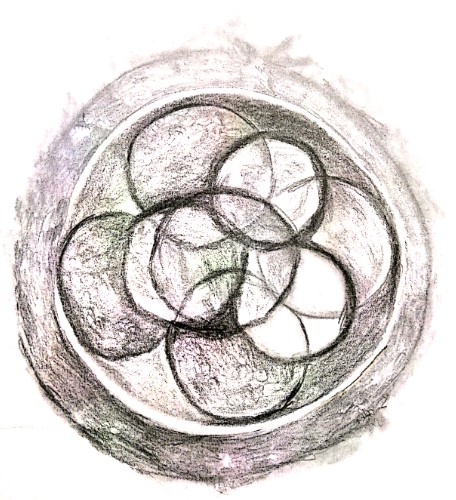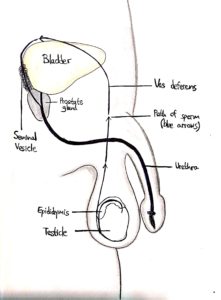Semen analysis is one of the first steps taken in the search process of diagnosing the causes of otherwise unexplained male infertility. A Seminogram (also comes in variant names: Spermiogram, Semenogram) -practically translating as transcription of Semen measuring, -is a study conducted to test and evaluate the overall quality of a male’s semen sample, this test is practically a battery of probes where the main attention is set on the sperm cells contained within the semen specimen.
Factors influencing sample quality
The ejaculate is made up of both sperm cells, released from the testes, and fluids, produced in accessory sex organs (the internal organs of the male reproductive system). Both are important contributing factors to the overall measurable quality of the sample, as the lab results will vary based on both the number of sperm counted and the total volume of the ejaculate. It is therefore important to note whether or not a complete sample is collected.
The results are also dependent on the time since the last ejaculation (see instructions to prepare for semen analysis): When ejaculation does not occur, the sperm cells begin to accumulate in the epididymides. If not empty, these older sperm cells will begin to break down and die.
The size of the testis is another important contributing factor that can influence the number of sperm seen on the seminogram, as it can reflect the level of sperm production.
Due to this large number of variable and mostly uncontrollable factors, there can be much variability in the quality of multiple samples from the same male collected at different periods of time. To obtain a complete picture, one must examine at least 2-3 samples, as it is impossible to definitively characterize a man’s semen quality from a single analysis.
Parameters measured in a semen analysis
Volume
The total amount of ejaculate produced is measured as the semen volume. A normal sample volume may range from 1.5-5 mL.
Precise measurement is important, as it allows the calculation of the total sperm count in the sample. A low semen volume, when one is certain the entire sample has been collected, can be an indicator of obstructive azoospermia or an underlying genetic condition.
Sperm Concentration
The number of sperm cells per unit of volume of semen, known as the concentration, is a function of the number of sperm cells ejaculated together with the amount of fluids that dilute them, released from the accessory organs. It is a relative measure and therefore does not reflect an accurate measurement of testicular function on its own.
Total Sperm Count
The total number of sperm cells in the entire ejaculate is calculated by multiplying the sperm concentration (a function of the unit of volume) by the total semen volume. A normal total sperm count is expected to be equal to or greater than 30 million.
The value of the total sperm count provides a measure of the level of testicular function.
Sperm Motility
The amount of moving sperm cells out of the total concentration is measured as sperm motility. The percentage of motility is expected to be 50% or greater. This is measured as the percentage of moving sperm cells.
This parameter is known to be an important factor when it comes to achieving pregnancy.
Type of Motility
The quality of sperm movement can be split and graded into three categories: progressive or non-progressive motility, and immotility. Progressive motility is the highest level, where the sperm cells under the microscope can be observed aggressively moving in a linear fashion, or in a large circle. Non-progressive motility is the category that represents all other swimming patterns, in which no active progress is made, such as small circles or tail movement. A grade of immotility indicates zero movements.
Liquefaction
Following ejaculation, a semen sample is typically a semi-solid mass which will almost immediately begin to thin out and liquefy at room temperature. Complete liquefaction will usually occur within 15 minutes, however, it may take up to 60 minutes or more.
Liquefaction is an important factor as it affects the ability of the sperm cells to move. Often, if high numbers of immotile sperm cells are seen on the Seminogram, more time must be allowed for the sample to completely liquefy.
Semen Viscosity
A regular semen sample that has liquefied, when aspirated into a pipette and then allowed to fall by gravity, will fall as small, individual droplets. If the droplets instead form a thread more than 2 cm long, this indicates abnormal viscosity. A highly viscous sample will also be stickier and more elastic.
The high viscosity of a sample can in turn interfere with other parameters, including sperm concentration and motility.
Appearance
Once a sample has liquefied, it should appear grey and opaque.
A lower concentration of sperm may cause the sample to be less opaque, and certain drugs or vitamins may cause the sample to appear more yellow.
pH
pH is a measure of the sample’s acidity. The overall acidity of the semen is a balance of the pH measures of the secretions which make up the sample. The pH should be measured within 1 hour of ejaculation, and normal pH should be greater than 7.2.
A low semen pH, when combined with other factors, may be an indicator of obstructive azoospermia (hyperlink) or an underlying genetic condition (hyperlink).
Sperm Morphology
The shape and structure of sperm cells vary tremendously. In order to assess the percentage of normal-shaped sperm, a stained slide is prepared from a small amount of the semen sample. Under a microscope, based on strict criteria (hyperlink to Kruger’s), the sample is analyzed one cell at a time, as each sperm cell is determined to possess normal or abnormal morphology.
The range of normal percentage values, according to Kruger’s strict morphology criteria, is between 4-14%. This means that in the semen sample of a fertile male, anywhere from 86-96% of the sperm will possess abnormal morphology.
Sample collection
Ideally, the sample should be obtained in a container, known to be non-toxic to sperm, through masturbation and collected in a private room located near the laboratory, to limit the time between sample collection and analysis. The collection should include the entirety of the ejaculate and occur after 2-7 days of sexual abstinence.
In extraordinary circumstances, such as a lack of appropriate facilities near the laboratory, a sample may be collected at home. In such a case, the same guidelines apply, and the time of collection should be recorded. The sample must be delivered to the laboratory within 1 hour of collection, and during that time it should be kept between 20 and 37 degrees Celcius.
If a patient is unable to produce a sample via masturbation, it may be collected at home by using a condom during sexual intercourse. The condom used must be a special collection condom, as regular condoms are designed to kill sperm and will affect the test results. It is also recommended not to use a lubricant, as most are also designed to kill sperm cells. Following ejaculation, the condom must be removed, closed, and delivered to the laboratory within 1 hour.


